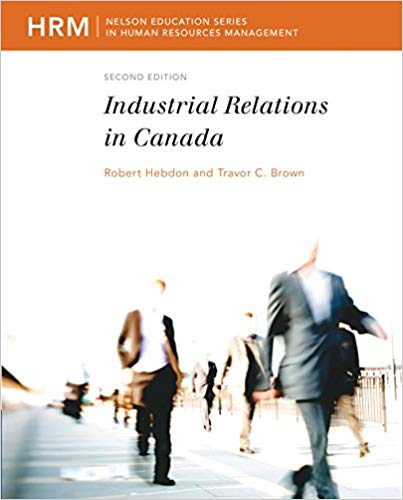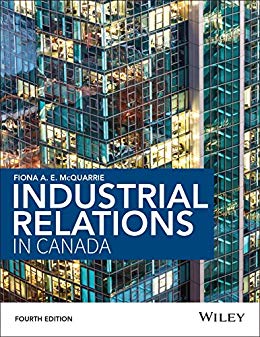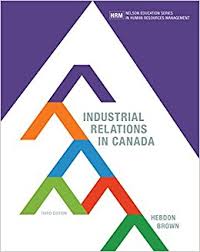Description
Test Bank For Industrial Relations in Canada 3rd Edition By Robert Hebdon
Name: Class: Date:
Chapter 2 – Labour History
1. Female telephone operators were actively involved in the Winnipeg General Strike. a. True
b. False
ANSWER: True
2. In a “master-servant relationship” the basis of the relationship is common law. a. True
b. False
ANSWER: True
3. The nine-hour movement was an international worker’s attempt to secure shorter working days. a. True
b. False
ANSWER: True
4. The Knights of Labor followed the founding principles of the AFL. a. True
b. False
ANSWER: False
5. The Knights of Labor were opposed to strikes. a. True
b. False
ANSWER: True
6. The Berlin Convention resulted in the TLC being comprised of many union affiliates. a. True
b. False
ANSWER: False
7. James Woodsworth formed the New Democratic Party (NDP). a. True
b. False
ANSWER: False
8. The One Big Union (OBU) is often associated with the Winnipeg General Strike. a. True
b. False ANSWER: True
Copyright Cengage Learning. Powered by Cognero. Page 1
Name: Class: Date:
Chapter 2 – Labour History
9. The Wagner Act required that employers bargain collectively with certified unions. a. True
b. False
ANSWER: True
10. The Rand Formula required that all dues would be paid directly to the employer. a. True
b. False
ANSWER: False
11. Mexico was included in the first (1987) Free Trade Agreement. a. True
b. False
ANSWER: False
12. Unifor is positioning itself as the advocacy for employed and unemployed. a. True
b. False
ANSWER: True
13. Which two groups were central to the start of the Winnipeg General Strike? a. metal workers and phone operators
b. receptionists and metal workers
c. phone operators and carpenters
d. carpenters and receptionists
ANSWER: a
14. What term refers to a process in which trainees learn a trade under the supervision of a senior tradesperson? a. trade school
b. development c. trade unionism d. apprenticeship
ANSWER: d
15. What aspect of the master-servant relationship did the labour movement try to change in the late 1800s? a. liberalized trade
b. failure to follow work orders
c. a large number of actors in the IR system
d. legal penalties for refusing work ANSWER: d
Copyright Cengage Learning. Powered by Cognero.
Page 2
Name: Class: Date:
Chapter 2 – Labour History
16. What was a key feature of the new model of unionism?
a. All members performed the same trade or speciality. b. Apprenticeships were excluded.
c. It provided a free supply of labour.
d. Unions favoured strike action.
ANSWER: a
17. Which of the following occurred first in Canadian labour history?
a. Berlin convention founds the National Trades and Labour Congress b. Trade Union Act passes
c. Public Service Staff Relations Act passes
d. Winnipeg General Strike
ANSWER: b
18. Why was the Nine-Hour Movement a significant point in Canadian labour history?
a. It established the right to strike.
b. It provided the foundation for the birth of a formalized Canadian labour movement. c. It abolished trade unionism.
d. It drew women into the labour movement.
ANSWER: b
19. When did the Nine-Hour Movement take place? a. 1867
b. 1872 c. 1886 d. 1919
ANSWER: b
20. What lasting impact of the Nine-Hour Movement is still felt in modern workplaces? a. labour standards that regulate overtime
b. a divide between craft and industrial unions
c. the master-servant relationship
d. tripartite labour boards ANSWER: a
Copyright Cengage Learning. Powered by Cognero.
Page 3
Name: Class: Date:
Chapter 2 – Labour History
21. Which of the following were guiding principles when the American Federation of Labor was founded? a. bipartisan jurisdiction
b. exclusive jurisdiction
c. overthrow capitalism
d. the right to strike
ANSWER: b
22. What terms refers to the idea that a single union represents all workers of an occupational group? a. exclusive jurisdiction
b. political nonpartisanship
c. business unionism
d. pure unionism
ANSWER: a
23. When was the Trade and Labour Congress (TLC) founded? a. 1872
b. 1880 c. 1886 d. 1888
ANSWER: c
24. Who is considered by many to be the founding father of the labour movement in Canada? a. Daniel O’Donoghue
b. John A. MacDonald
c. John Dunlop
d. Mackenzie King
ANSWER: a
25. Which of the following was one of the differences between the AFL and the TLC? a. multiple union membership
b. collective bargaining
c. innovative social policy
d. addressing power imbalances ANSWER: c
Copyright Cengage Learning. Powered by Cognero.
Page 4
Name: Class: Date:
Chapter 2 – Labour History
26. When was the Knights of Labor formed? a. 1867
b. 1869 c. 1918 d. 1925
ANSWER: b
27. What dividing feature of the early movement to unionization was highlighted by the Berlin Convention of 1902? a. fear of financial insolvency
b. tripartite conflict resolution
c. struggle between craft versus industrial unionism
d. business unionism
ANSWER: c
28. Who was credited with developing the 1907 Industrial Disputes Investigation Act? a. Daniel O’Donoghue
b. Alton Craig
c. Greg Kealey
d. Mackenzie King
ANSWER: d
29. Which aspect of Canadian labour relations is similar to labour relations in the United States? a. the Berlin Convention division of the labour movement along craft/industrial lines
b. allowing civil servants to unionize
c. legislated grievance procedures
d. elements of social unionism in the national federation of labour
ANSWER: a
30. When did the Winnipeg General Strike take place? a. 1918
b. 1919 c. 1940 d. 1945
ANSWER: b
Copyright Cengage Learning. Powered by Cognero.
Page 5
Name: Class: Date:
Chapter 2 – Labour History
31. Why was the Winnipeg General Strike remarkable?
a. It united the western labour movement.
b. It was the first large-scale series of sympathy strikes. c. It brought bargaining rights to all employees.
d. It resulted in One Big Union in Canada.
ANSWER: b
32. Which labour union from the early 20th century is still active, and currently trying to organize workers at Starbucks? a. One Big Union
b. Industrial Workers of the World
c. Canadian Trades and Labour Congress
d. Unifor
ANSWER: b
33. What term best describes unions that organize all workers of an industry or workplace regardless of occupation? a. workplace unions
b. democratic unions
c. trade unions
d. industrial unions
ANSWER: d
34. When did the Wartime Labour Relation Regulation (P.C. 1003) come into effect? a. 1919
b. 1939 c. 1944 d. 1949
ANSWER: c
35. How is Canadian labour legislation different from the Wagner Act?
a. Canadian labour legislation requires mandatory grievance procedures.
b. Canadian labour legislation requires that employers bargain collectively with certified unions. c. Canadian labour legislation defines unfair labour practices.
d. Canadian labour legislation adheres to the doctrine of inclusivity.
ANSWER: a





Be the first to review “Test Bank For Industrial Relations in Canada 3rd Edition By Robert Hebdon”